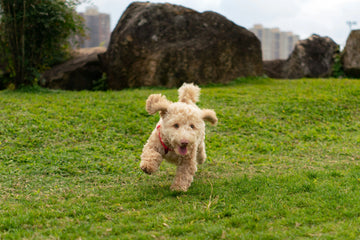On a weekend morning, as you pack your luggage, your furry friend gazes at you with anticipating eyes. "Should I take them on vacation?" This thought suddenly crosses your mind. As a pet parent who frequently travels with dogs, I know that a pleasant dog on vacation experience requires thorough preparation. Let's explore how to plan a perfect vacation with your dog.

I. Which Dogs Are Suitable for Taking on Vacation?
Before booking tickets or packing for your dog, first objectively assess whether they're suitable for travel. Like humans, not all dogs are meant to be "four-legged travelers."
Dogs particularly suitable for travel: Consider taking your dog on vacation when they possess these traits:
- Cheerful personality and adaptable to new environments
- Adult dogs with basic training and good health
- Familiar with car environments and not prone to motion sickness
- Breeds that remain calm around unfamiliar environments and people
Dogs that should stay home: Just as we wouldn't take a friend with a cold on a long trip, dogs in the following conditions are better left at home:
1. Those with health concerns:
- Dogs in recovery
- Puppies under 6 months or elderly dogs with weak health
- Those requiring regular medication
- Pregnant dogs
2. Dogs with special conditions:
- Large breeds with hip issues, as long journeys can be burdensome
- Breeds with special spinal conditions like Dachshunds
- Brachycephalic breeds like French Bulldogs and Pugs, which are prone to heatstroke
- Small breeds sensitive to environment changes, as travel stress might affect them severely

II. Pre-trip Preparations for Taking Your Dog on Vacation
1. Transportation Preparation:
For self-driving trips, the car becomes your dog's second home:
- Prepare suitable car seats for safety and comfort

- Clean the car interior and eliminate odors
- Check the air conditioning system
- Pack motion sickness medication if needed
For public transportation:
- Review pet policies carefully
- Book pet-friendly seats near exits
- Purchase appropriate pet carriers
- Prepare necessary health documents
2. Accommodation Preparation:
Finding suitable lodging is as important as choosing a holiday hotel for children:
- Prioritize hotels with pet gardens
- Confirm room location away from noisy areas
- Research nearby dog-walking parks
- Choose off-peak travel times for more space

III. Essential Packing List
Just like packing for a child, taking your dog on vacation requires a careful equipment checklist. Each item serves as a "travel guarantee" for your beloved pet. Let's review these indispensable companions.
1. Daily Necessities:
These "life essentials" are crucial. Imagine your dog's comfort when seeing familiar bowls and favorite toys in an unfamiliar environment.
Food and Dining Items:
- Regular dog food, pack 1-2 extra days' worth
- Appropriate treats for comfort and training
- Collapsible food and water bowls, preferably silicone
- Portable water bottle for hydration
Travel Equipment:
- Two leashes (one primary, one backup)
- Properly sized collar or harness with contact information
- Favorite toys for emotional comfort
- Professional pet cleaning supplies including dry shampoo, wipes, and waste bags
2. Safety Equipment:
Safety always comes first. These items serve as "insurance" for unexpected situations.
- Long-lasting pet GPS tracker with full battery
- Well-fitting reflective vest
- LED collar light for night activities
- First aid kit including antiseptic, gauze, styptic powder, tweezers
- Natural insect repellent
- Regular medications if needed
3. Documents:
These documents serve as your dog's "ID cards" and should be kept in a waterproof container:
Essential Documents:
- Vaccination records with valid dates
- Recent health certificate
- Microchip information copies
- List of veterinary clinics along route and at destination
- Pet insurance documentation if applicable

IV. Travel Considerations
Taking your dog on vacation is like traveling with a non-verbal child, requiring constant attention to their condition. These considerations ensure a safe and enjoyable journey.
1. Car Safety:
Long drives challenge both humans and dogs. Proper rest and care make the journey more pleasant.
- Limit food intake 2 hours before departure
- Provide small amounts of water during travel
- Schedule breaks every 2-3 hours for exercise and bathroom
- Watch for signs of restlessness
- Monitor ventilation in back seat and trunk areas
2. Environmental Adaptation:
Each new environment is an adventure for dogs. Helping them transition smoothly is crucial.
Upon Arrival:
- Allow 15-20 minutes of free exploration
- Set up feeding and bedding areas similar to home
- Keep first day activities minimal
- Maintain regular schedules
- Bring familiar items for comfort
Routine Maintenance:
- Keep feeding times consistent
- Maintain regular exercise schedule with weather adjustments
- Create a dedicated rest area with familiar items
Emotional Monitoring:
- Watch for appetite changes
- Address stress signs promptly
- Increase positive interactions and rewards

V. FAQ
Q1: How to handle motion sickness?
A: Control feeding times, ensure ventilation, use motion sickness medication.
Q2: What about emergencies?
A: Carry first aid kit, keep vet contacts handy, consider pet insurance.
Q3: How to help dogs adjust to new environments?
A: Bring familiar items, maintain routines, provide rewards and comfort.

Taking your dog on vacation isn't just travel; it's precious bonding time. With proper preparation and attention to your pet's needs, you'll create wonderful memories together. Remember, the journey's value lies not in destinations reached, but in the joyful moments shared. Wishing you and your furry friend a delightful vacation!






